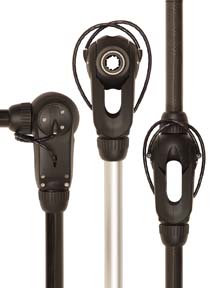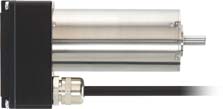We have all seen industrial robot arms — solid constructions for heavy tools — and they are pretty hefty themselves. In fact, these designs are simply too heavy for many applications. Engineers at igus in Cologne (www.igus.com) wanted to develop a multipleaxis joint that would allow small loads to be swiveled or turned around a jib. They needed high levels of flexibility and low weight, with simple upgrade options for additional axes. These requirements have now been elegantly translated into a new concept with a multiple-axis joint made from plastic and cable controls.
The cables themselves are moved from the arm's “shoulder joint” using compact, high-performance, brushless dc-servomotors. This prevents inertia in the arm, allows dynamic movements and means the drive block can be compact in design.

Fig. 1: An articulated robot using the igus Robolink, a free-range robotic joint.
Bionic methods
To avoid having to reinvent the wheel, the team of engineers looked at further refining the trusted human elbow joint. This allowed two degrees of freedom — rotation and swivel — to be incorporated in a single joint, thereby providing high levels of precision for the moving parts. The tribo-plastic joint is also maintenance-free and does not corrode or conduct electricity. The “bones” of the arm to which the joints are attached are also pared down to a lightweight construction. Aluminum, carbon fiber, and fiberglass-reinforced plastic provide excellent rigidity and good vibration insulation.
As in the human arm, the weakest components of this kind of robot arm are not the bones (i.e., the body tube) or the muscles (i.e. the drive motor) but rather the “tendons” which transfer the power. The high-tension “tendons” or control cables are therefore made of a highly wear resistant and tensile load resistant fiber made from highly crystalline, UHMW-PE (ultra-high molecular weight polyethylene). With tensile strength of 3,000 to 4,000 N/mm2 , it only breaks under its intrinsic weight at a length of 400 km. This design allows a load/intrinsic weight ratio of 1:1 to be achieved, or even less if the structure is optimized. As well as the traditional robot arm functions, the joint can be used for new functions such as special fittings for cameras, sensors, or tools where lightweight construction is key. In the future, it may even be used on prosthetics. It is the separation of the tool, the moving parts, the control module and the actual drive that make it ideal for mobile use.

Fig. 2: Robolink joints have a transmitted torque (rotation) of from 5 to 7 Nm in continuous operation.
As the components that have been removed from the moving parts represent a sort of counterweight to the mass of the arm, the overall structure is very light. A magnetic angle position sensor is built into every joint to improve precision. Combined with the highly dynamic drives, this produces a precision-controlled robot module.
Powerful and compact drives
Compact drive solutions are required in order to operate the largest possible number of cable controls within a confined space. Where high levels of dynamism, real power yield, and precise, controllable use are required, electronically commuted servomotors are the best option. The small compact drives have a low moving mass and an outstanding performance to volume ratio, making them ideal for dynamic use. The excellent heat deflection allows considerable overload when operated for short periods, which is a big advantage when it comes to fast swivel movements.
The motor operating voltage of 24 Vdc is perfectly tailored to battery power; crucial for mobile applications. The 32-mm-diameter motor gives a high output and can yield 80% efficiency in four-quadrant mode. The 97-mNm torque of the four-pole motor is increased by the diameter-compliant planetary gearheads to the values required to operate the arm. Depending on the area of application for the swivel movement, the planetary gearheads allow ratios of 1:4 to 1,600 or 6 to 20 Nm continuous torque at up to 96% efficiency. The stainless steel casing is as weatherproof as the plastic joints and cable controls.
The fact that brushless drives have no wearing components, apart from the rotor bearing, guarantees a long service life over many tens of thousands of hours. The precision gearheads also boast a long no maintenance service life. The motor can be operated in temperatures from –40° to +100°C, the gearheads from -25° to +90°C. This means they can both cope with environmental conditions from the Arctic to the tropics, and thus a wide range of industrial operating conditions.
Modern servomotors are the tool of choice for various applications where movement is required in the construction process. High precision levels and a long service life combined with easy integration into the control system mean they can be used both for mobile application.

Fig. 3: The 3268 brushless motor with planetary gearhead provides 38.5 W.
An example of a motor that perfectly fits this application would be the 3268 BX4 motor from MICROMO. This motor has a 32-mm diameter and, at a length of 68 mm, provides the required 97-mNm torque. It features an ironless stator coil, high reliability and long operational lifetime, no sparking or cogging, and a dynamically balanced rotor. This motor can have optional digital or analog hall sensors.
Advertisement
Learn more about MICROMO Electronics





